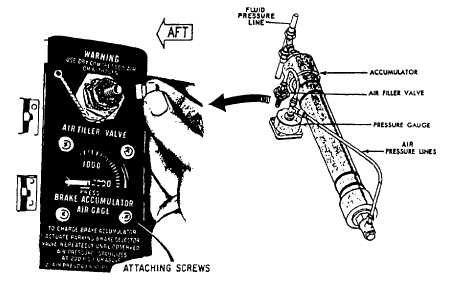perform the same function—that of storing an extra
volume of hydraulic fluid under pressure.
Maintenance
Accumulators should be visually examined for
indications of external hydraulic fluid leaks. They
should then be examined for external air leaks by
brushing the exterior with soapy water, which will
form bubbles where the air leaks occur.
The air valve assembly should be loosened to
examine the accumulator for internal leaks. If
hydraulic fluid comes out of the air valve, the
accumulator should be removed and replaced. The
overhaul or repair of the accumulator is not a line
maintenance function, but it is the responsibility of an
intermediate-level activity.
The air preload pressure should be checked after
relieving the hydraulic system pressure by operating
the wing flaps or other hydraulically actuated unit.
The majority of the accumulators installed in naval
aircraft are equipped with air pressure gauges for this
purpose. When the accumulator is not equipped with
a high-pressure air gauge, you may install one at the
air preload fitting for this purpose. The required
pressure can be found in the MIM for each aircraft.
The preload pressure may be checked by another
method in case the accumulator is not equipped with
an air pressure gauge. With the system pressure (as
indicated by the cockpit gauge) at the normal
operating value, relieve system pressure by operating
the wing flaps or another unit slowly. The pressure
gauge reading must be watched carefully. The last
reading before the indicator needle drops suddenly to
zero is accepted as the accumulator preload air
pressure.
Before disassembly of any accumulator, ensure
that the air preload has been completely exhausted.
This may be accomplished by loosening the swivel
nut on the air filler valve until all air is out; then
remove the valve.
Servicing
The purpose of the hydraulic system accumulator
is to store an extra volume of fluid under pressure.
The energy stored in an accumulator is used for
various purposes, such as the actuation of a unit in the
event of normal hydraulic system failure. For
example, sufficient energy can be stored in an
accumulator for several applications of the wheel
brakes.
Most accumulators are installed with an air gauge
and a high-pressure air valve mounted on a panel of
the structure near the accumulator.
Figure 7-35
shows the brake system accumulator installation used
on one type of aircraft.
The air valve used in the
accumulator installations is usually the same type as
that used on shock struts.
Figure 7-35.—Accumulator air charge valve and gauge installation.
7-38

